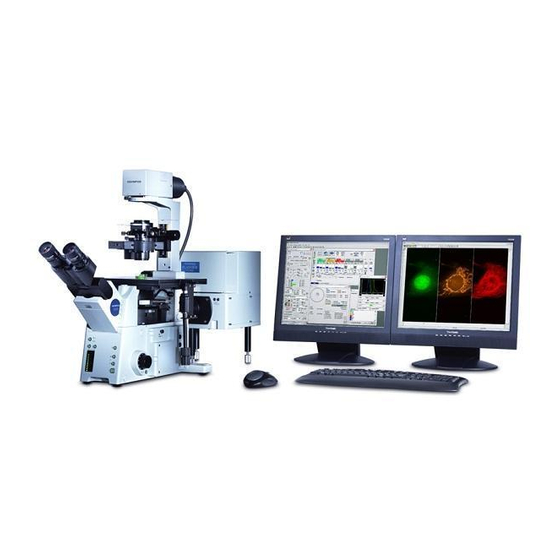Olympus Fluoview FV1000 사용자 설명서 - 페이지 37
{카테고리_이름} Olympus Fluoview FV1000에 대한 사용자 설명서을 온라인으로 검색하거나 PDF를 다운로드하세요. Olympus Fluoview FV1000 42 페이지. Confocal microscope
Olympus Fluoview FV1000에 대해서도 마찬가지입니다: 개요 (28 페이지), 간단한 지침 (7 페이지), 간단한 지침 (7 페이지), 사용자 설명서 (9 페이지), 매뉴얼 (3 페이지)

1 Troubleshooting Guide
The system may be unable to manifest its full performance due to its usage as well as malfunction. In
case a problem occurs with the system please check the following list to find appropriate
countermeasures.
If the problem cannot be resolved by the described remedial action, please contact Olympus for repair.
Irregularity
1. Laser is not output from
the extremity of the
objective.
2. Fluorescence image
cannot be observed.
Cause
The laser unit is not turned ON.
The laser wavelength is not selected. Check the laser wavelength to be used.
The manual shutter of the
fluorescence mirror unit is closed.
(Manual system only)
The reflective mirror inside the
fluorescence mirror unit is not in the
light path. (Manual system only)
The objective is not in the light path. Engage the desired objective in the light
The laser beam is too weak.
The properties of the combined cube
unit used for the ASU (auxiliary scan
unit) or OPD (non-confocal point
detector) do not match the selected
laser wavelength.
The confocal pinhole diameter is too
small.
The excitation Dichroic Mirror
selection does not match the
observed fluorescence wavelength
and excitation laser wavelength.
The spectral dichroic mirror and
barrier filter selections do not match
the observed fluorescence
wavelength.
The acquisition wavelength region
setting is not suitable for the
observed fluorescence wavelength.
(Spectral detection system only)
The fluorescent dyeing method and
excitation wavelength do not match
each other.
Focus is not adjusted.
The PMT voltage of the detector is
too low.
Troubleshooting Guide
Remedy
Turn on the laser unit. Make sure that the
emission key is set to ON.
Open the manual shutter.
Engage the reflective mirror in the light
path.
path. When using a manual revolving
nosepiece, be sure to stop the objective in
the click position.
Increase the laser intensity.
Engage a DM cube unit matching the
selected laser wavelength in the light
path.
Increase the pinhole diameter.
Engage a DM optimum for the observed
fluorescence and excitation laser
wavelengths.
Engage a spectral DM and barrier filter
matching the observed fluorescence in
the light path.
Set an acquisition wavelength region
matching the observed fluorescence.
Select a laser optimum for the fluorescent
dyeing method.
Adjust the focus.
Increase the PMT voltage.
III. TROUBLE Q&A
Page
III. 1 - 1
